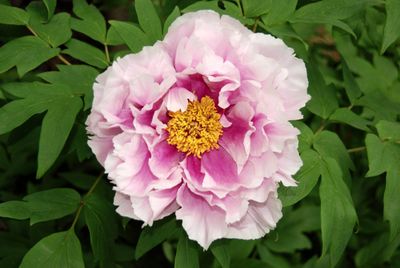What are Tree Peonies?
Herbaceous peonies are perennial peonies that die back to the ground each year. The roots remain dormant under the soil, then the plant stems push up in the spring. Tree peonies are woody, deciduous shrub peonies. They lose their foliage in the fall but their woody stems do not die back to the ground like herbaceous peonies. Itoh peonies are a hybrid cross between herbaceous peonies and tree peonies, they do die back to the ground in fall like herbaceous peonies but their flower and growth characteristics are similar to tree peonies. Native to China, tree peonies were valued as a medicinal plant long before they were adored ornamentals. Tree peonies are larger, woody relatives of the common herbaceous peony, growing up to 5 feet (1.5 m.) wide and tall in about ten years. They are highly prized for their large, prolific blooms that can grow up to 10 inches (25+ cm.) in diameter. These flowers, which bloom in late spring to early summer, make excellent cut flowers and come in single or double forms. Unlike herbaceous peonies, the flower buds of tree peonies do not produce the sweet honeydew sap that attracts ants.
How to Grow a Tree Peony
While some varieties of tree peonies are hardy down to zone 3, most tree peonies are hardy in zones 4-8. They do best where they have a cold winter for dormancy and hot summers. Usually labeled as full sun plants, tree peonies prefer some dappled to light shade from the hot afternoon sun. Too much intense sunlight can cause the beautiful flowers to fade and wither quicker. They prefer slightly alkaline soil and proper drainage is essential. Tree peonies also prefer a site where they do not have to compete with roots from other shrubs or trees. They do best with perennial companion plants. New tree peony plants should be planted in spring or fall, not during the heat of summer. They can be slow at first to get established, sometimes taking up to three years to grow much or bloom. Once established, tree peonies are drought tolerant and do not transplant well. A properly placed, content in its environment plant can live up to a hundred years. Tree peony care in gardens is not any more complicated than herbaceous peony care. However, unlike herbaceous peonies, tree peonies should never be cut back in autumn. Tree peonies should only ever be pruned or cut back to shape or remove dead, damaged or diseased wood. They have high iron and phosphate needs and may benefit from an annual feeding of iron sulphate and bone meal in spring. Tree peonies should also be fertilized regularly with a general purpose fertilizer that is higher in phosphorus than nitrogen and potassium, like 5-10-5. Tree peonies can be susceptible to fungal diseases, so it’s best to water them directly at the root zone. They can also be damaged by borers, so check regularly for signs of borer holes in the wood. Before winter, apply a protective layer of mulch over the plant’s root zone.
